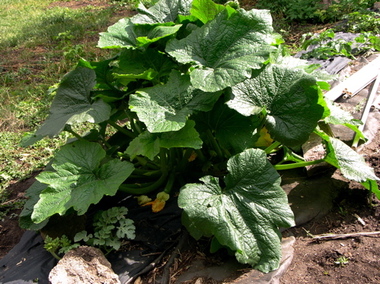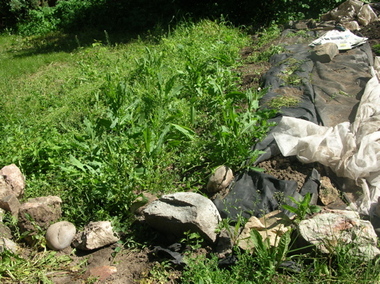I’ve gotten a couple of interesting responses to my earlier posts, Bindweed #1 and Bindweed #2 (thrilling titles, eh? Makes me feel like the Cat in the Hat introducing Thing 1 and Thing 2) which I’ll take up in more detail in a separate installment. Alan of Roberts Roost has suggested that bindweed is evidence of calcium deficiency. Has anyone else heard this?
Any other experiences, advice, or rumors (we’re scraping the bottom of the barrel, here) about bindweed?
Okay, on to the business of the day, which is this:
How to grow vegetables on a bindweed-infested patch with no blood, minimal sweat, and very few tears.
This post was inspired by one of the photos sent me by Laura, whose query about bindweed started this whole series. Even though it’s in the first of my posts on the topic, I’m going to save everyone a click and reproduce it here:
That was taken a couple of months ago (I got the photos on July 25), and Laura says that everything in the foreground of the photo in front of the beets is bindweed, to which I say, That’s a lot of bindweed.
As Victoria of Victoria’s Backyard says in her comment on Bindweed #2, reducing the plant’s ability to photosynthesize will damage it. It’s the extensive root system that makes these plants so incredibly hard to deal with, but it’s the foliage that feeds the roots. So reducing foliage, in any way at all, will eventually do in the roots as well.
Mowing will damage the plant, but covering it would be better. With a patch that size, I’d recommend covering it with black plastic mulch if you’re not using that space, or with a layer of newspaper and then tough weedcloth if you are. You can plant right through the cloth—the bigger the plant the better, so that very few holes need be cut through which weeds can emerge.
Squash is perfect, because it’s got a single stem, but potatoes or any large plants are also possible.
Here’s what it can look like when you’ve done a slap-dash job and then suffered three hail storms in July:
Way behind that zucchini, you can see the tail end of the strip of weedcloth, with a couple of potato plants poking up through it. Behind them all on the left is a patch I haven’t tackled yet, save to spend about ten or fifteen minutes, maybe three times in the season, yanking plants. The first time, when it was really bad, I started by raking.
This is what that looked like on June 27, a few weeks after my first raking and yanking pass:
It’s not under perfect control by any means, but I feel I’m giving the damned things a run for their money, with a minimal investment of my time.
Here’s the method:
Dig the worst of the bindweed roots out of the places where you’ll put the plants, then lay down either chipped wood mulch or newspaper with very tough weedcloth on top. The mulch or paper is to ensure that NO light gets to the plants underneath. No light means no leaves, and the object, you may recall, is to kill off foliage.
After the weedcloth is down, cut Xs in it over in the prepared spots Make the Xs just big enough to let you set out transplants or to allow seedlings to emerge. If you’re planting seeds, fold back (or under) the edges of the X, using small rocks to keep the edges out of the way until the seedlings make their appearances. Once they’re up, or your transplants are in the ground, close the Xs around the stems (gently), "suturing" them with garden staples to hold the flaps down.
If you want to know how angels feel, (aren’t they next-door to perfection?), measure one of the long arms of your X and cut a circle of weedcloth that’s several inches larger in radius than that measurement, so it extends well beyond the X. Make a single cut to the center, so that you can now lay it down over the X with the squash transplant at the middle A large squash might need a bit more room than this gives it; another, much smaller X in the center will leave room for a growing stem.
Make sure that the cut in the circle lies between two arms of the X, so that there’s no place where the cuts line up. If there is, bindweed will find it. Then use a couple of garden staples to close the circle along the cut. Use as few as possible, as every hole in the weedcloth gives the bind-weed a point-of-entry to the upper world. Rocks can be used to hold down the outer edge of the circle.
Some bindweed will emerge around the stems, but not much, and the weedcloth will cut the number of weeds down to a manageable level. Once the squashes reach full size, they shade the cloth, and bindweed doesn’t like shade. This is one way to get some use out of a pretty badly infested spot without having to dig up the whole thing.
It’s almost like getting a free lunch. Not quite, but almost.




 Subscribe to RSS feed
Subscribe to RSS feed



According to AN ACRES U.S.A. PRIMER, a book I would highly recommend for anyone interested in eco-farming, bindweed thrives in places where the soil pH is out of balance and the processes of decomposition and decay of organic matter have broken down. Both of these things are indicative of calcium imbalance. Having a soil test and working to balance the soil chemistry, coupled with weeding to weaken the plants resources should eliminate the problem.
I have been meaning to weigh in on the bindweed question since post one but keep forgetting. Not that I have anything remarkable or significant to add – I just wanted to contribute. Also to confess: one of my greatest pleasures is digging up bindweed. There is something extremely satisfying in tracing the fat wormy roots around the place. digging deeper and deeper in a fruitless search for the fount of all bindweed.Even better is to fill a bucket with roots and to go and put them in the centre of a very hot bonfire.
It may be a little perverse but I promise that at least I remain fully clothed at all times.
I cant give specific ideas for bindweed (heck! I dont even know which one of assorted weeds it is … every weed here is known by its local equivalent for ‘grass’).But one suggestion would be to do what the local farmers here do. In summer when all the weeds dry up, they dig up the soil and make teeny-tiny (about 6″ – 1′ high) bonfires all over the plot of land which is to be planted on. This effectively kills off all weeds and their seeds and also any lurking pests. The ash from this is then used to fertilise the soil.
I’m going to respond to all of these in a later post. Thanks for contributing, everyone!
–Kate
I read this post with great interest because I “inherited” a lot of bindweed when I bought my house. The former owner had landscape fabric covering everything but the bindweed still managed to thrive. The only method I’ve found to keep it under control is just good old fashioned hand pulling. It’s definitely helped but I have to stay on top of it. I’m wondering if there is really any way to truly eradicate it??!
You truly are a great gardener! All the passion you put into what you do will surely pay off big time! (Well,it probably has already) Hoping that you can spread your love for gardening to more people. Your bindweed solutions are simply admirable.